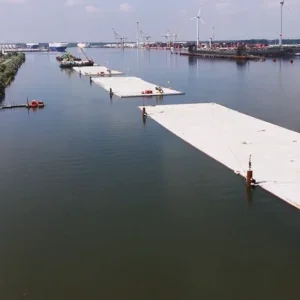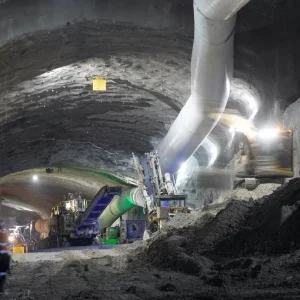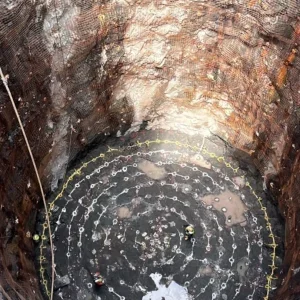Speakers
Bill Grose
Bill is a civil engineering consultant on major underground infrastructure works, and has spent the last three years working independently after retiring from his 35-year career at Arup. His areas of expertise include risk management and forensic investigation of failures. While most of his 40 years in the industry have been spent on tunnelling projects across the world, Bill’s work has included five years leading the planning and design of London’s Olympic Park and two years with HMTreasury researching costs of UK infrastructure Bill is a Fellow of the Institution of Civil Engineers, was chairman of BTS from 2006 to 2008, presented the Harding Lecture in 2012, and has served two three-year terms on ICE Council. He has been associated with the Tunnelling Codes of Practice since their inception in 2003.
Patrick Bravery
Patrick is a chartered civil engineer with experience of design, construction and management roles on commercial, infrastructure and transportation projects. He joined the insurance industry 15 years ago and has acted as lead insurer of major transportation projects such as Terminal 5 Heathrow, LTA Singapore, MTA New York and Doha Metro, Qatar. Patrick is an active member of the construction insurance community having been involved in the launch of the International version of the Tunnel Code of Practice, lecturing at both the Warwick MSc and BTS Design and Construction courses and latterly taking the chair of the International Tunnelling Insurance Group ITIG. He is a vocal advocate of the value of risk management in construction.
Nigel Legge
Nigel is a UK chartered civil engineer with more than 30 years industry experience in the UK and internationally. He has worked on a number of major European civil infrastructure projects including HS2, Crossrail, Heathrow Terminal 5, the Alp Transit rail project in Switzerland and the UK Channel Tunnel. He has been involved in the insurance industry for a decade, involved with more than 40 projects in sectors including metro and rail transportation, roads, hydropower, port terminals and mining. He leads an independent firm of consultants providing project advisory and expert technical services in connection with civil and structural engineering and mining projects.
Kevin Province
Kevin is a chartered civil engineer and chartered safety practitioner. Kevin has been working as an insurance risk engineer for more than 20 years, following his early design, safety and construction management experience. In this role, Kevin has visited more than 200 civil engineering and building projects, including major tunnels and infrastructure schemes around the world. He has served on the Institution of Civil Engineers Health & Safety Board and has a specialist interest in construction fire safety issues, making contributions to best practice guidance in this field. Society expects continuous improvement. History tells us that as we learn lessons from past failures, the incidence of failures will reduce, but at the same time the tolerance of failure by society reduces as well. Stretching back over 2,000 years, the construction industry has a long history of collapse and failure to learn from it.
In 27 AD, an apparently cheaply-built wooden amphitheatre, collapsed in Fidenae near Rome resulting in by far the worst stadium disaster in history with anywhere between 20,000 and 50,000 dead and wounded out of the total audience of 50,000.
The emperor Tiberius had banned gladiatorial games, and when the prohibition was lifted, the public had flocked to the event. Consequently, a large crowd was present when the stadium collapsed.
Proving the point that “lessons learned” is not a new phenomenon, the Roman senate responded to the tragedy by requiring that all future amphitheaters were to be erected on a sound foundation, and also inspected and certified.
Other significant construction collapses through the ages include churches – the UK’a Lincoln cathedral collapsed in 1285 – bridges, dams, and towers.
There are fairly frequent tunnel collapses too. Since 1964, there have been 52 recorded significant tunnel failures during construction and operation including those caused by fire and flood, a rate of one to two per annum. Do we as an industry learn from recent failures? Following the Heathrow collapse in 1994, the HSE published a report in 1996 on the safety of New Austrian Tunnelling Method (NATM) tunnels and again in 2000 a report on the Heathrow collapse itself.
Only a few years later in 2004 the Nicoll Highway collapse in Singapore revealed massive procedural and technical failings.
The official report cited “lamentable errors”, “regulatory weakness”, “neglect of statutory duties” and “warnings of collapse at an early stage not taken seriously”.
These reports were well read at the time but it is questionable as to whether the lessons were taken on board, we need to challenge our industry to make sure the staff of today understand the mistakes of the past.
CATASTROPHIC EVENTS AND MITIGATIONS
Catastrophic events – such as structural failure, temporary works failure, tunnel collapse, crane failure, flood or fire – are known as “black swan” events – high impact and low probability.
In its 2011 publication Preventing Catastrophic Events in Construction, the HSE has provided guidance on their identification and prevention.
FIRE
The risk of fire is not often considered to be major on a civil engineering project during construction. However, there are case histories and fire can lead to a loss of life and total loss of assets. Two notable recent tunnel fires during construction include:
¦ Storebaelt in 1994. A possible electrical fault ignited an aerosol of TBM hydraulic oil. The crew escaped, but the fire burned for two days and caused significant damage.
¦ A86 in Paris in 2002. A diesel locomotive caught fire behind the TBM and ignited running slab formwork. The TBM crew escaped to the refuge chamber where they remained for nine hours before they could be rescued.
Lessons have been learned. Recent initiatives or inventions that have been developed in response to fire or the threat of fire include: steel fibre reinforced tunnel linings that don’t spall explosively coupled with polypropylene fibres added for additional fire resistance, hydraulic oil has been developed that is fire resistant and TBMs have refuge areas at face for the crew. These are all reactionary, so we need to look beyond the Tunnel Joint Code of Practice (of which there is more later) for best practice guidance on fire hazard management.
And while there have been initiatives as described above, there are still opportunities for the industry to improve. For example, fuel-driven plant and equipment is not always fire suppressed, the location and fire suppression of gas bottles is often overlooked and there are opportunities for early compartmentation and reduction of the temporary fire load during construction phasing.
Early engagement with the fire and rescue service is paramount in fire safety and prevention. This should include measures such as “familiarisation” tours with the first responders, agreement on access, communications and locations of hydrants and breeching points.
There are many lessons for the industry from the Grenfell Tower fire in London, June 2017. It is likely that this event will have been considered a high impact event with a low probability and perhaps therefore not given the risk attention that it was due. The consequences will no doubt have ramifications across the industry for some years to come.
There are parallels to make between the Grenfell Tower fire and a TBM tunnelling project. Consider a tower block to be a TBM on its end. There is a dead end to escape from, just like a TBM and an unprotected escape route. Sprinklers or fire suppression would considerably reduce risk and designers/ building owners could consider placing a refuge chamber at the top of a tower block just like a TBM has near the face. THE CAUSES OF TUNNELLING FAILURES
Recent tunnelling failures can be attributed to:
¦ The ground, e.g., Rio Metro and Pinheiros Station, January 2007 – this could be due to variability in ground conditions, incomplete records or complex behaviour.
¦ Design and construction, e.g., Gerrards Cross – Failure of supporting structures, interaction issues or complex intermediate construction causing unforeseen loading. Fire or flood.
¦ Complexity: multiple parties, disciplines and phases, and interfaces be they design, construction, internal, external, environmental or third parties
¦ Organisational issues, systemic failures such as the Heathrow collapse
¦ Planning issues – project delays and or cost overruns
¦ Human factors, e.g., Buncefield Oil Storage Depot, not a tunnelling project but a serious failure where management systems for filling oil tanks were found to be not only deficient but also, or perhaps consequently, not followed.
As the reports from previous failures will elaborate, there is rarely a single cause. We build defensive layers into our project management processes, each layer can be considered as a slice of swiss cheese – it will have holes or weaknesses in it. With enough layers or processes, it will not be possible for all holes to line up and allow an incident to occur.
THE PRACTICE OF RISK MANAGEMENT
Prior to the 1990s, risk management didn’t really feature in every day construction practice. PERT analyses were introduced in the 1950s and Monte Carlo analyses in the 1970s, but these were not used as a matter of course on a construction project.
Since then the science of risk management has developed considerably. Through the 1990s to the present-day, legislation and industry reviews have provided much guidance. From the Latham and Egan reports in the 1990s through to Joint Code of Practice for Risk Management of Tunnelling Works (JCOP), CDM Regs, Tunnel Code of Practice for Risk Management of Tunnel Works (TCOP) and ISO 3001 Risk Management principles and Guidelines 2009, the industry has had much instruction.
There are now a number of risk management systems to assist the project team in managing risk. The topic has spawned a number of specific phrases – risk architecture, risk appetite and risk protocols. However the output will only be as good as the management process. Risk engineering typically covers project and organization management, status and programme, design process, change and innovation, natural hazards, third parties, interfaces, HSE, quality management, I&M, for safety and flood risk. There are many tools to help the project management team: risk assessments and registers, detailed and location-specific registers, and cost and programme risks trackers. Often however there is little or no involvement by key suppliers in the system – does the main contractor regularly involve its key subcontractors, or does the client regularly involve the contractor?
PROCESS OF RISK MANAGEMENT
The risk register is a central facet of the risk management process. This is often generated in a large workshop with lots of attendees breaking down a project into its constituent operations and then discussing the risks associated with each one. However, does the project management team ever consider if these are the right people with the right skills and competences to be assessing these risks?
The risk workshop may identify high impact – low probability events correctly (such as a tunnel collapse, fire or flood) but then assess them as a low risk due to the very low probability of occurrence. This course of action is incorrect. The consequences are too severe to ever be assessed as a low risk and effectively ignored. This mistake can be mitigated to a certain extent through the use of more sophisticated risk matrices that include a modicum of quantification
RISK MANAGEMENT CONCLUSIONS
1) Project delivery is impacted by a wide spectrum of risks. One must consider a full range of hazards bearing in mind as discussed earlier in this section, tunnel ‘failure’ can be more than just collapse.
2) Adequate assessment of material damage risks. It is easy to get lost within complex ERM models. Don’t ignore the ‘Black Swan’ events 3) TCoP: Has this been effective? There is a correlation between positive TCoP benchmarking and good risk management. It has been a significant contribution to advancing risk management and is discussed further 4) There is a virtuous circle of risk management in UK projects, from JLE, to HS1, T5, Crossrail and now onto Tideway and HS2.
5) There is an opportunity for BTS members to have a positive influence on the risk management of oversea projects. 6) Instill a risk culture on projects. Risk management is top down and risks silo-ing the issue. Management of risk is bottom up – consult those at the sharp end.
INSURERS’ PERSPECTIVE ON RISK
Insurance is a form of financial risk management used to hedge against the risk of an uncertain loss. It provides a defined financial compensation given a defined event. It relates to the quantum and timing of a claim and does not transfer “construction risk” to the insurer.
Insurance is not an alternative to the management of risk on site. It is to protect the financial position of the insured in the event that construction risk management fails, or the residual risk after mitigation transpires.
There are four different responses to risk. 1) High impact, high probability risks are likely to be terminated. That is, is it possible to find an alternative, less risky activity? 2) Low impact, high probability risks can be treated through the introduction of control measures. 3) Low impact, low probability risks can be tolerated – business as usual. 4) High impact, low probability risks can be mitigated and the residual risk covered through insurance.
THE ROLE OF THE UNDERWRITER
The underwriter will commonly look at four “pillars.” 1) Who – is involved in the project, their experience and Expertise
2) What – is being constructed and the inherent risks involved 3) Where – the environment, weather, flood risk and ground risk 4) How – what is the programme and budget, are they adequate and what could be the residual effect on the quality of the project.
They will look to see if the project will be delivered successfully – effective risk management will increase the likelihood of success.
As stakeholders in the project, they will undertake a risk management survey to help align success for everyone. This will be done throughout the project through a programme of risk surveys, benchmarking the project against industry best practice (JCOP and TCOP). They will physically inspect the works during construction and provide feedback in the form of observations and recommendations.
As partners in risk sharing the underwriters have a role to play in sharing experiences, lessons learned and relationship building with the aim of reducing risk.
HISTORY
Towards the end of the 20th century, there was a crisis in confidence due to significant losses exacerbated by an erosion of capital base following 9/11.
Many insurers withdrew from the market or went out of business. Civil engineering was the worst performing industry; the worst projects were rarely on time, budget or to specification and within that, tunnelling was performing the worst of the worst.
So, business came together and in 2003 produced the Joint Code of Practice for Risk Management of Tunnelling Works (JCOP) in the UK followed by the Tunnel Code of Practice for Risk Management of Tunnel Works (TCOP) in 2006, revised in 2012.
TCOP is considered by insurers as being best practice, not just for tunnel works but for all major civil construction projects. It is comprehensive covering all design and procurement stages and outlining obligations on clients, designers and contractors. Remembering that effective management of risk will increase the likelihood of success.
Ask does it work? Are there fewer claims/disruptive events? Is risk management embraced and embedded? Even, has the industry moved on leaving the code behind?
The International Tunnelling Insurance Group (ITIG) is undertaking a review of the code to respond to these questions. This will involve an analysis of projects before and after release of the code, global variations in application of risk management methods and the impact of other developments such as health and safety legislation.
The conclusion from the insurance industry would be that, the insurance and the tunnelling industries have collaborated to define best practice in risk management and that this effective risk management is viewed as the enabler to the success of a project.
Remember that insurance can provide an essential financial compensation post-event service but this is a financial product, it does not cover soft issues such as reputation, uninsured costs or human/environmental costs.
FINAL CONCLUSIONS
What can we as a tunnel industry do? The following comprise the speakers’ suggestions:
¦ Tunnelling carries significant risk, lessons are learned (sometimes) and the industry requires a greater awareness, and better communication and education. The message to the industry is to learn the history and apply lessons learned, perhaps make it compulsory CPD.
¦ Competence in design and construction is essential in properly assessing risk good technical understanding of the technical engineering is needed.
¦ Be aware of and worry about black swan events – only engineers can do this as they know the risks. These events tend to get insufficient attention by project teams but cannot be ignored and if not mitigated have higher probabilities than one might think.
¦ Insurance is important but will not prevent things going wrong.
¦ Expect the unexpected.
¦ Don’t rely on risk managers.







